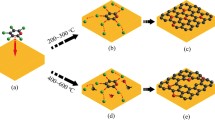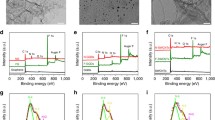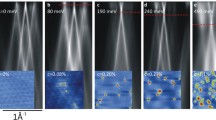Abstract
We have reported a novel route to develop highly conductive graphene sheets using camphor as a natural precursor followed by nitrogen doping via low-temperature post-annealing treatment. The effect of nitrogen-doped (N-doped) graphene sheets and undoped graphene sheets on electrical properties has been studied in detail. We reveal that by precise control of post-annealing temperature and nitrogen doping level, the sheet resistance of graphene can be achieved to as low as ~ 280 Ω/□ as well as demonstrating N-type degenerate semiconducting properties. Moreover, we have performed ab initio calculations of undoped and N-doped graphene with varying concentrations of 1%, 2%, 3% and 5% doping in a supercell of 100 atoms. A semi-empirical Extended Hückel Tight Binding model was utilized to study the Bandgap, projected density of states (PDOS) and the Total Energy of all the doped and undoped graphene structures. It was found that with an increase in the dopant concentration in a monolayer graphene supercell leads to an opening in the bandgap at the k-point of the band structure. These results lead to an agreement of N-type behavior of the graphene structure which is supported by the PDOS results of the valence orbitals of graphene.







Similar content being viewed by others
References
Novoselov KS, Geim AK, Morozov SV, Jiang D, Zhang Y, Dubonos SV, Grigorieva IV, Firsov AA (2016) Electric field effect in atomically thin carbon films. Science 306:666–669
Balandin AA (2011) Thermal properties of graphene and nanostructured carbon materials. Nat Mater 10:569–581
Morozov SV, Novoselov KS, Katsnelson MI, Schedin F, Elias DC, Jaszczak JA, Geim AK (2008) Giant intrinsic carrier mobilities in graphene and its bilayer. Phys Rev Lett 100:11–14
Chen JH, Jang C, Xiao S, Ishigami M, Fuhrer MS (2008) Intrinsic and extrinsic performance limits of graphene devices on SiO2. Nat Nanotechnol 3:206–209
Huang Y, Liang J, Chen Y (2012) An overview of the applications of graphene-based materials in supercapacitors. Small 8:1805–1834
Williams JR, DiCarlo L, Marcus CM (2007) Quantum hall effect in a gate-controlled p–n junction of graphene. Science 317:638–641
Wolf EL (2014) Applications of graphene: an overview. Springer, Cham
Chung C, Kim YK, Shin D, Ryoo SR, Hong BH, Min DH (2013) Biomedical applications of graphene and graphene oxide. Acc Chem Res 46:2211–2224
Heersche HB, Jarillo-Herrero P, Oostinga JB, Vandersypen LMK, Morpurgo AF (2007) Bipolar supercurrent in graphene. Nature 446:56–59
Meric I, Han MY, Young AF, Ozyilmaz B, Kim P, Shepard KL (2008) Current saturation in zero-bandgap, top-gated graphene field-effect transistors. Nat Nanotechnol 3:654–659
Son YW, Cohen ML, Louie SG (2006) Energy gaps in graphene nanoribbons. Phys Rev Lett 97:1–4
Bai J, Zhong X, Jiang S, Huang Y, Duan X (2010) Graphene nanomesh. Nat Nanotechnol 5:190–194
Gui G, Li J, Zhong J (2008) Band structure engineering of graphene by strain: first-principles calculations. Phys Rev B Condens Matter Mater Phys 78:1–6
Dvorak M, Oswald W, Wu Z (2013) Bandgap opening by patterning graphene. Sci Rep 3:1–7
Guo B, Liu Q, Chen E, Zhu H, Fang L, Gong JR (2010) Controllable N-doping of graphene. Nano Lett 10:4975–4980
Deifallah M, McMillan PF, Corà F (2008) Electronic and structural properties of two-dimensional carbon nitride graphenes. J Phys Chem C 112:5447–5453
Xu H, Ma L, Jin Z (2018) Nitrogen-doped graphene: synthesis, characterizations and energy applications. J Energy Chem 27:146–160
Zhang C, Fu L, Liu N, Liu M, Wang Y, Liu Z (2011) Synthesis of nitrogen-doped graphene using embedded carbon and nitrogen sources. Adv Mater 23:1020–1024
Jia L, Wang DH, Huang YX, Xu AW, Yu HQ (2011) Highly durable N-doped graphene/CdS nanocomposites with enhanced photocatalytic hydrogen evolution from water under visible light irradiation. J Phys Chem C 115:11466–11473
Li M, Wu Z, Ren W, Cheng H, Tang N, Wu W, Zhong W, Du Y (2012) The doping of reduced graphene oxide with nitrogen and its effect on the quenching of the material’s photoluminescence. Carbon N Y 50:5286–5291
Cui L, Chen X, Liu B, Chen K, Chen Z, Qi Y, Xie H, Zhou F, Rümmeli MH, Zhang Y, Liu Z (2018) Highly conductive nitrogen-doped graphene grown on glass toward electrochromic applications. ACS Appl Mater Interfaces 10:32622–32630
Zafar Z, Ni ZH, Wu X, Shi ZX, Nan HY, Bai J, Sun LT (2013) Evolution of Raman spectra in nitrogen doped graphene. Carbon N Y 61:57–62
Wang C, Zhou Y, He L, Ng TW, Hong G, Wu QH, Gao F, Lee CS, Zhang W (2013) In situ nitrogen-doped graphene grown from polydimethylsiloxane by plasma enhanced chemical vapor deposition. Nanoscale 5:600–605
Lin L, Li J, Yuan Q, Li Q, Zhang J, Sun L, Rui D, Chen Z, Jia K, Wang M, Zhang Y, Rummeli MH, Kang N, Xu HQ, Ding F, Peng H, Liu Z (2019) Nitrogen cluster doping for high-mobility/conductivity graphene films with millimeter-sized domains. Sci Adv 5:1–10
Wei D, Liu Y, Wang Y, Zhang H, Huang L, Yu G (2009) Synthesis of n-doped graphene by chemical vapor deposition and its electrical properties. Nano Lett 9:1752–1758
Lv R, Li Q, Botello-Méndez AR, Hayashi T, Wang B, Berkdemir A, Hao Q, Eléas AL, Cruz-Silva R, Gutiérrez HR, Kim YA, Muramatsu H, Zhu J, Endo M, Terrones H, Charlier JC, Pan M, Terrones M (2012) Nitrogen-doped graphene: beyond single substitution and enhanced molecular sensing. Sci Rep 2:1–8
Smidstrup S, Markussen T, Vancraeyveld P, Wellendorff J, Schneider J, Gunst T, Verstichel B, Stradi D, Khomyakov PA, Vej-Hansen UG, Lee ME, Chill ST, Rasmussen F, Penazzi G, Corsetti F, Ojanperä A, Jensen K, Palsgaard MLN, Martinez U, Blom A, Brandbyge M, Stokbro K (2020) QuantumATK: an integrated platform of electronic and atomic-scale modelling tools. J Phys Condens Matter 32:015901
Kresse G, Furthmüller J (1996) Efficient iterative schemes for ab initio total-energy calculations using a plane-wave basis set. Phys Rev B Condens Matter Mater Phys 54:11169–11186
Soler JM, Artacho E, Gale JD, García A, Junquera J, Ordejón P, Sánchez-Portal D (2002) The SIESTA method for ab initio order-N materials simulation. J Phys Condens Matter 14:2745–2779
Giannozzi P, Baroni S, Bonini N, Calandra M, Car R, Cavazzoni C, Ceresoli D, Chiarotti GL, Cococcioni M, Dabo I, Dal Corso A, De Gironcoli S, Fabris S, Fratesi G, Gebauer R, Gerstmann U, Gougoussis C, Kokalj A, Lazzeri M, Martin-Samos L, Marzari N, Mauri F, Mazzarello R, Paolini S, Pasquarello A, Paulatto L, Sbraccia C, Scandolo S, Sclauzero G, Seitsonen AP, Smogunov A, Umari P, Wentzcovitch RM (2009) QUANTUM ESPRESSO: a modular and open-source software project for quantum simulations of materials. J Phys Condens Matter 21:395502
Wu M, Cao C, Jiang JZ (2010) Light non-metallic atom (B, N, O and F)-doped graphene: a first-principles study. Nanotechnology 21:505202
Rani P, Jindal VK (2013) Designing band gap of graphene by B and N dopant atoms. RSC Adv 3:802–812
Ullah S, Hussain A, Syed W, et al (2015) Band-gap tuning of graphene by Be doping and Be, B co-doping: a DFT study. RSC Adv 5:55762–55773. https://doi.org/10.1039/C5RA08061D
Denis PA (2010) Band gap opening of monolayer and bilayer graphene doped with aluminium, silicon, phosphorus, and sulfur. Chem Phys Lett 492:251–257
Chaliyawala HA, Rajaram N, Patel R, Ray A, Mukhopadhyay I (2019) Controlled Island formation of large-area graphene sheets by atmospheric chemical vapor deposition: role of natural camphor. ACS Omega 4:8758–8766
Kern W, Puotinen DA (1970) Cleaning solutions based on hydrogen peroxide for use in silicon semiconductor technology. RCA Rev 31:187–206
Chaliyawala HA, Narasimman R, Pati RK, Mukhopadhyay I, Ray A (2021) Effect of copper pretreatment on optical and electrical properties of camphor-based graphene by chemical vapour deposition. J Mater Sci Mater Electron 33(11):8397–8408
Stokbro K, Petersen DE, Smidstrup S, Blom A, Ipsen M, Kaasbjerg K (2010) Semiempirical model for nanoscale device simulations. Phys Rev B Condens Matter Mater Phys 82:1–7
Cerdá J, Soria F (2000) Accurate and transferable extended Hückel-type tight-binding parameters. Phys Rev B - Condens Matter Mater Phys 61:7965–7971
Jin Z, Yao J, Kittrell C, Tour JM (2011) Large-scale growth and characterizations of nitrogen-doped monolayer graphene sheets. ACS Nano 5:4112–4117
Bahamon D, Khalil M, Belabbes A, Alwahedi Y, Vega LF, Polychronopoulou K (2021) A DFT study of the adsorption energy and electronic interactions of the SO2 molecule on a CoP hydrotreating catalyst. RSC Adv 11:2947–2957
Farmanzadeh D, Ghazanfary S (2013) The effect of electric field on the interaction of glycine with (6,0) single-walled boron nitride nanotubes. J Serbian Chem Soc 78:75–83
Chaliyawala HA, Purohit Z, Agarwal N, Gupta G, Ray A, Mukhopadhyay I (2019) A solid carbon source based high performance mono/bi layer graphene/SiNWs heterojunction NIR photodetector. Opt Sens 11028:1102803
Acknowledgements
The authors thank Pandit Deendayal Energy University (PDEU) for providing the necessary facilities to carry out this investigation. Financial support from Solar Research and Development Center (SRDC), PDEU, is deeply acknowledged.
Author information
Authors and Affiliations
Corresponding authors
Ethics declarations
Conflict of interest
The authors declare no conflict of interest.
Additional information
Handling Editor: M. Grant Norton.
Publisher's Note
Springer Nature remains neutral with regard to jurisdictional claims in published maps and institutional affiliations.
Rights and permissions
About this article
Cite this article
Vemuri, S.K., Chaliyawala, H., Ray, A. et al. A powerful approach to develop nitrogen-doped graphene sheets: theoretical and experimental framework. J Mater Sci 57, 10714–10723 (2022). https://doi.org/10.1007/s10853-022-07239-z
Received:
Accepted:
Published:
Issue Date:
DOI: https://doi.org/10.1007/s10853-022-07239-z




